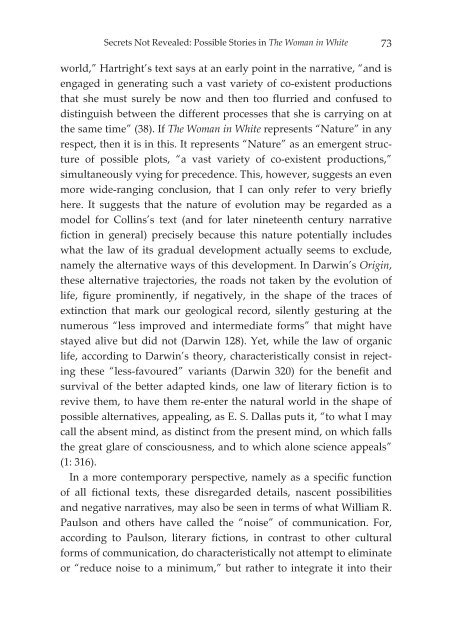Connotations 18.1-3 (2008/2009)
Connotations 18.1-3 (2008/2009)
Connotations 18.1-3 (2008/2009)
Create successful ePaper yourself
Turn your PDF publications into a flip-book with our unique Google optimized e-Paper software.
Secrets Not Revealed: Possible Stories in The Woman in White<br />
world,” Hartright’s text says at an early point in the narrative, “and is<br />
engaged in generating such a vast variety of co-existent productions<br />
that she must surely be now and then too flurried and confused to<br />
distinguish between the different processes that she is carrying on at<br />
the same time” (38). If The Woman in White represents “Nature” in any<br />
respect, then it is in this. It represents “Nature” as an emergent structure<br />
of possible plots, “a vast variety of co-existent productions,”<br />
simultaneously vying for precedence. This, however, suggests an even<br />
more wide-ranging conclusion, that I can only refer to very briefly<br />
here. It suggests that the nature of evolution may be regarded as a<br />
model for Collins’s text (and for later nineteenth century narrative<br />
fiction in general) precisely because this nature potentially includes<br />
what the law of its gradual development actually seems to exclude,<br />
namely the alternative ways of this development. In Darwin’s Origin,<br />
these alternative trajectories, the roads not taken by the evolution of<br />
life, figure prominently, if negatively, in the shape of the traces of<br />
extinction that mark our geological record, silently gesturing at the<br />
numerous “less improved and intermediate forms” that might have<br />
stayed alive but did not (Darwin 128). Yet, while the law of organic<br />
life, according to Darwin’s theory, characteristically consist in rejecting<br />
these “less-favoured” variants (Darwin 320) for the benefit and<br />
survival of the better adapted kinds, one law of literary fiction is to<br />
revive them, to have them re-enter the natural world in the shape of<br />
possible alternatives, appealing, as E. S. Dallas puts it, “to what I may<br />
call the absent mind, as distinct from the present mind, on which falls<br />
the great glare of consciousness, and to which alone science appeals”<br />
(1: 316).<br />
In a more contemporary perspective, namely as a specific function<br />
of all fictional texts, these disregarded details, nascent possibilities<br />
and negative narratives, may also be seen in terms of what William R.<br />
Paulson and others have called the “noise” of communication. For,<br />
according to Paulson, literary fictions, in contrast to other cultural<br />
forms of communication, do characteristically not attempt to eliminate<br />
or “reduce noise to a minimum,” but rather to integrate it into their<br />
73

















